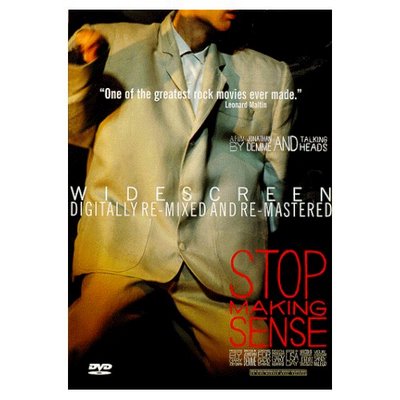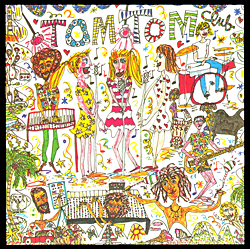
“ONE OF THE GREATEST ROCK MOVIES EVER MADE”
Stop Making Sense is a concert film performed by the Talking Heads at Pantages Theater in Hollywood, California. Filmmaker Jonathan Demme (Silence of the Lambs, Philadelphia) directed the film, blending musical and cinematic elements. In December 1983, while the Talking Heads were promoting their new album Speaking in Tongues, Demme and Talking Heads vocalist David Byrne organized a three-night concert. Scenes from this three-night period are used in the film. The film documents a live concert of the Talking Heads performing in front of a live audience. Additionally the film introduces an innovative technological advancement in music and cinema. It is the first film that uses only digital audio techniques. Stop Making Sense is therefore a groundbreaking production.
"I CANT SLEEP 'CAUSE MY BED"S ON FIRE, DONT TOUCH ME 'CAUSE IM A REAL LIVE WIRE"
The film begins with David Byrne walking on stage with a large boombox and guitar. As he slowly approaches the front of the stage, Byrne sets the boombox down and presses play. Byrne’s action in the opening scene initiates music. The popular and well-known song Psycho Killer is the first song that plays while David Byrne dances with his guitar.
A single Talking Heads member accompanies Byrne after each song. By using this process, the film is perceived as a visual and musical progression of elements. The musical group grows in size after every song until it reaches the sixth track “Burning Down the House”. This song features all the members of the Talking Heads on stage for the first time. Notably, Byrne exits the stage for one song, “Genius of Love” which is sung by female musician Tina Weymouth. The Tom Tom Club, an alter ego of the Talking Heads, performs the energetic “Genius of Love” track. This marks a climax in the film: strobe lighting techniques, lengthy editing, close camera angles, enthusiastic dancing routines and the speedy tempo of the music all operate with a vigorous sense of energy. The Talking Heads enhance this dynamic audio and visual presentation with back-up singers and dancers, a keyboardist, a percussionist and an additional base guitarist.

David Byrne sports an iconic, over-sized suit for the entire concert. This adds a dimension of absurdity to the film. Personally, Byrne’s suit is one of the lasting images of the film. One cannot forget the ridiculous costume paired with the Talking Heads’ inventive music.
The film Stop Making Sense is completely original in the way it interacts with its audience. While viewing the film, shots of the audience do not exist until the sixteenth and final track “Cross-Eyed and Painless”. The placement of the camera, ignoring the live audience, enhances the Talking Heads’ ability to confront and stimulate the film viewer. All of the action is confined to the stage, producing a powerful and active composition for the camera. Byrne purposely intended on this method, because it enables the film-viewer to construct original impressions without the influence of the present and visible audience.
After each song, a different stage design is used as a visual backdrop. Stop Making Sense is unique because it uses no colored lights. Every concert has to provide lighting for the musical group to perform. However, when illuminating the Talking Heads only white light was used. During the song “Naïve Melody (This Must Be the Place)”, the Talking Heads use a human-sized lamp to illuminate the dark stage. Enriching the visual and audio elements, the lamp is Byrne’s dancing partner throughout the song. The improvisational movement of the lamp provides a spontaneous dimension to the film’s cinematography.

Stop Making Sense was edited in an unconventional manner. In relation to other audio and visual performances of the time, the film incorporates long takes into its production. Long shots and edits of the Talking Head’s performance enable the spectator to analyze the visual relationships between the artists and their environment. A lengthy edit stimulates a detailed understanding of the concert’s action. The track “Once in a Lifetime” is almost all one distinct shot. Following the source of action, the camera takes a semi-distant position. This perspective displays David Byrne’s entire body. Byrne reacts to the music; each separate body part produces a rhythmic interpretation of what it hears.

THEMATIC LINKS:
Definitive Talking Heads Fan Site:
www.talkingheads.net
Stop Making Sense wikipedia site:
http://en.wikipedia.org/wiki/Stop_Making_Sense"
No comments:
Post a Comment